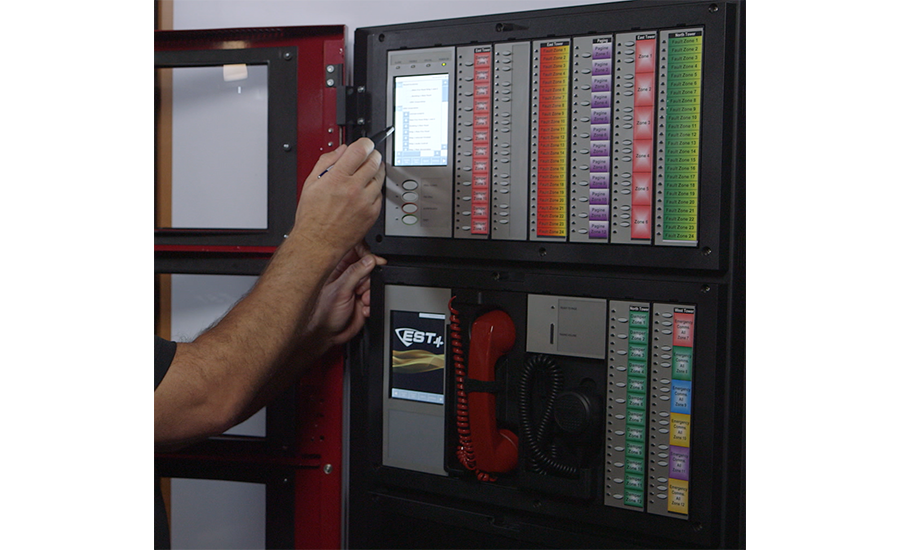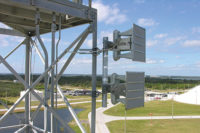Emergency Communications Systems: For Emergencies & Operational Messaging

Many emergency communications systems, such as Zenitel’s, can be integrated with systems such as IP video and access control so they can gain additional information, such as from surrounding camera views, or complete actions, such as opening doors or gates and establishing an audit trail. || IMAGE COURTESY OF ZENITEL

Talkaphone introduced its bAlert Personal Safety and Collaboration platform in 2020, a system that integrates multiple methods of communicating emergencies to first responders, including traditional 911 phone calls, smart device apps, desktop apps, Bluetooth panic buttons, and blue light phone towers and call stations. It also has the WaveSense touch-free call stations and COVID-19 self-assessment feature. || IMAGE COURTESY OF TALKAPHONE


Emergency communications systems (ECS) encompass a wide variety of technologies, configurations and applications — and their usage can be surprisingly linked to the coronavirus pandemic.
Some ECS systems are intercom-based and may or may not be similar to the traditional blue-light towers often seen on campuses and in parking garages. Others are an outgrowth of fire alarm panels, originally designed to provide mass notification of life-safety emergencies. Still others are designed expressly for all types of emergency alerting using the most modern forms of communication available, including texting, digital signage, and social media. What they all have in common, however, is their ability to alert large masses of people as well as smaller, select groups to deliver messages of an emergency or non-emergency nature.
The pandemic has changed many things, including ECS, as systems have taken on a greater role due to how business is conducted today. And because of that, some aspects of emergency communications have changed, particularly how they conduct non-emergency messaging.
Lessons From the Pandemic
Dave Sweeney, general manager of Advantech, Dover, Del., a Security-Net member, says emergency communication systems are inherently challenging because people have different expectations and beliefs about what they can do and how they should best communicate the message. “Because of these varying degrees of understanding or definitions, we always rely upon the NFPA 72 Chapter 24 for emergency communication system guidelines because we feel that should be the foundation for any emergency notification system that you design, build or deploy,” he says.
He adds, “Codes are focused on protecting people in the building; if you’re not in the building, you are in less risk. That is the premise of most of the codes and by broadcasting a pre-recorded message you are capturing everyone in the building — visitors, contractors, and employees.”
But the pandemic has changed how people traditionally have used buildings for school, work, or recreation. The fact that buildings today have lower occupancy rates than they did pre-COVID-19 is leading Advantech, a security integrator, to evaluate how they can leverage the capabilities of emergency notification systems differently. “It’s important to go beyond looking at getting the message to building occupants and instead look at whether we are getting the message to the right people and how to do that,” Sweeney says. “Email notification, SMS, and different third-party platforms that offer web interfaces that manage these notification systems are all capabilities and components that many of our customers evaluate. However, what we have seen is an uptick in people realizing they might need to expand that notification sphere to outside of the building because of today’s flexible work dynamic.”

The COVID-19 pandemic brought to the forefront the role that buildings play in affecting human health and well-being, says Jon Hughes, vice president, marketing and product strategy at Edwards, Bradenton, Fla. Since people have begun returning to commercial buildings and campuses, it’s apparent that not only are there fewer employees and students within buildings, but that they are occupying these buildings in a much more distributed fashion. “In this new, staggered approach to building occupancy, it’s harder to keep track of people coming and going, which makes it more challenging to communicate with them during an emergency event,” he says. “These reasons necessitate systems having as many touchpoints as possible for reaching occupants in the event of an emergency.”
In addition, vendors acknowledge the current trend for building systems to be accessible remotely due to the unexpected and limited open and close times of many buildings. “From the standpoint of our customers, the pandemic has sparked a demand for system information to be accessed remotely for health and safety purposes,” Hughes says. “Traditionally, building personnel would need to access a fire panel locally, but solutions like Edwards FireWorks incident management platform can provide information and updates about the system in real time in a centralized fashion, even when panels are distributed throughout a campus or property.”
John Holba, portfolio leader for building communications products at Honeywell Building Technologies, based in Atlanta, says, “There has always been the need across the industry to be less disruptive and the pandemic has highlighted this with limited access to buildings. Remote monitoring and diagnostics are important to meeting the needs of today’s customers and providing more information and time savings.”

The new Edwards Genesis LED strobe expander G4SE Series have just been made available as part of the expanding portfolio of Genesis LED Series Notification Devices. || IMAGE COURTESY OF EDWARDS
In addition to buildings housing fewer and more dispersed occupants, and operators needing to access systems remotely, a third pandemic lesson is the desire for greater collaboration among a company’s departments, says Todd Miller, senior vice president of strategic programs at Rave Mobile Safety, Framingham, Mass.
This trend prompted Rave to introduce Rave Collaborate, a companion to the company’s emergency notification solution. Let’s say a facility needs to shut down because of a COVID-19 outbreak. Once the emergency system reports the outbreak, there may be dozens of other things the company needs to do before reopening: notifying its management team, updating human resources, deploying a memo to the rest of the staff, bringing in a deep-cleaning crew, and more.
“Our customers said there has to be a way that we can leverage what we’re doing with our communication system, because so many of these aspects have a communication element to them,” Miller says. “Rave Collaborate is about providing a digital checklist, a way of tracking tasks and activities, and then leveraging both emergency and non-emergency communications within that collaboration space. It also has the ability to share resources such as maps.”
How ECS Are Used Differently
Over the last 18-plus months, Hughes says Edwards has seen an increase in construction in the industrial manufacturing and distribution industries, and these businesses are thinking proactively about employee safety in all aspects. Corporations are working with their environment, health and safety departments to determine how they can better communicate with occupants spread out across massive buildings when an incident occurs. “In some of these buildings, you might have 400 people working over 3 million square feet of space, so traditional systems aren’t as effective,” Hughes says. “Instead of a single point of contact, such as text messaging, they want to reach employees through paging systems, video displays, computers, mobile devices and virtually any other means that can communicate a message to an employee in the event of an emergency.”
In the same vein of targeting people with more precise messaging, Rick Focke, director of product management, enterprise access control at Johnson Controls, Milwaukee, says suppliers in general are moving toward pure IP-based solutions that can harness integration capabilities. “For example, our C•CURE 9000 event management system seamlessly integrates with the Lynx Duress & Notification system so that if an event is triggered in C•CURE, the system will automatically send out a notification or message via network-based loudspeakers, LED displays, or to existing radio systems,” he says.
Like the other experts, Focke has noticed an increased emphasis on working remotely, so the ability to muster so managers can know who is in the building and who isn’t is extremely important. “We are also pushing more communication out beyond just an audible announcement to employees inside a building, to also include employees working remotely,” Focke says.
In addition, the pandemic has certainly extended perimeters well beyond the traditional greeting of visitors at a receptionist’s desk inside a building. Face-to-face communication is now much more limited in commercial and educational facilities.
“It has made our product more required, the idea of audio more desirable. You have now pushed the perimeter from the desk to the front door, or maybe even to the gate,” says Bruce Czerwinski, vice president of sales and business development at Zenitel, Kansas City, Mo. Due to that distancing factor, the pandemic is stimulating usage of ECS for conveying more than just emergencies. For example, if someone had a flat tire in a parking garage, they could use the ECS to request assistance in lieu of approaching the security desk.
With the proliferation of remote communication, it’s more important to be able to hear and be heard — and to be understood — so people can respond to emergencies and first responders can assist them. Zenitel’s ECS solution offers both two-way communication through the intercom, and broadcast communication through, say, a speaker mounted in an intercom station tower. “For us, layering means different layers of communication. There’s one-to-one, one-to-many, or one-to-all,” Czerwinski says of Zenitel’s ECS. “The pandemic has made that more important, because first responders don’t want to have to go knocking on every door; they’re trying to do that more efficiently.”

Kevin Lehan, national sales manager at EMERgency24, Des Plaines, Ill., has witnessed a gain in popularity during the pandemic for the BluePoint end-user app and the www.ursecure.com portal. EMERgency24 is a strategic partner to BluePoint Alert Solutions, Elgin, Ill., which sells its ECS through security dealers and monitors them in EMERgency24’s central station. Lehan says the app helps companies easily keep their databases current as employees come and go — especially important during the current tumultuous employment market.
The BluePoint emergency communication system is a bit different than others. Either a “pull station” or a mobile pendant device are used to trigger a pre-recorded audio message and blue strobe lights. That signal is then received by the EMERgency 24 central station where it is treated as the highest priority. The central station contacts the authority having jurisdiction (AHJ) or other appropriate security entity. Simultaneously, the system initiates automated texts, emails, and phone calls seconds after the device is activated. These notifications can go to anyone inside or outside the facility. The dedicated and secure two-way communication platform allows first responders and building occupants to remain informed as situations are resolved and all individuals are accounted for, says Dave Ochs, executive vice president at BluePoint Alert Solutions.
As with other systems, companies can customize the BluePoint system to send any type of emergency or non-emergency message. Users can attach additional information to messages, such as a building layout showing safe areas in which to shelter during a weather event, for example. “That’s where I think technology is taking us is that you have all these capabilities now that use your phone and the technology to give people information you couldn’t give them before in a way that’s so beneficial,” Ochs says.
Prior to the pandemic, active-shooter situations were a key driver of many changes to ECS, specifically the need to identify where an active shooter was located and inform people in harm’s way about what actions to take, says Greg Sink, president and CEO, Talkaphone, Niles, Ill. “The pandemic has certainly tested the ability of emergency communications systems, as the need to disseminate information that was changing daily was needed to keep people at businesses, healthcare institutions, and educational campuses informed on the latest safety procedures and protocols.”
As with anything, a combination of forces often works together to shape technology and its uses, says Miller at Rave Mobile Safety. But over the last two years, the pandemic has accelerated what emergency managers, safety officials, and HR officials had already been thinking about: the trend of operational messaging. “I think folks recognize that when you have an outstanding emergency notification system or a mass notification system that is able to quickly deliver multimodal messages — while that is really essential and works well in emergency scenarios — they also have uncovered a lot of non-emergency scenarios that are a critical part of their operations,” he says.
For example, because of COVID-19, a company may be operating normally one day, and shut down the next. Shutting down a shift and/or closing the entire next day’s operation is not a critical emergency that you’d want to sound the sirens on; it’s more of an operational message, Miller says. “And there’s been a lot more of that because things have changed very quickly. You could be operating at full capacity today, but completely shut down tomorrow. Or think about the supply chain issues that we’re having. You’re operating at full capacity and now you’re not getting that stock in that you were expecting next week, so you need to make some schedule changes.”
He says a lot of his customers have started to operationalize many more of those communications and Rave will continue to help its users leverage that because they recognize they can’t sound an alarm for everything.
Changes Over Time
Sink of Talkaphone says mass notification systems — a term sometimes used interchangeably with emergency communications systems, but with its own distinct characteristics — were originally used as civil defense systems during the Cold War era. They later transitioned to weather-warning systems and eventually expanded to include all hazard warnings, including man-made or natural disasters such as weather, acts of terrorism, hazmat/chemical spills, and transportation accidents.
Today, these systems not only inform communities, but can also collect critical information about a situation by allowing first responders to collaborate with an emergency caller.
Selling emergency communications systems that companies can remotely access is one of the biggest changes that systems integrator Johnson Controls attributes to COVID-19. “The pandemic is a reminder that we always need to be prepared for the unexpected,” says Osvaldo San Martin, vice president and general manager of security solutions at systems integrator Johnson Controls, Milwaukee. “Offering digital, data-driven solutions that provide remote access and an advanced level of operational insights delivers an advanced level of preparation.”
Better preparing its customers is what led Johnson Controls to launch its connected fire panels offering, which allows facility managers to check the health of all their fire panels from a smartphone or laptop, he adds. This system also sends mobile push notifications for an emergency situation, which allows managers to be confident in the safety of their buildings no matter where they are. “Remote ECS prepares our customers to handle any emergency from anywhere and give occupants the peace of mind that their health and well-being are protected,” San Martin says.
Still, even though ECS are finding additional usage for operational messaging during the pandemic, it ultimately comes down to the security industry providing security, safety, and well-being to their customers, no matter the solution.
Looking for a reprint of this article?
From high-res PDFs to custom plaques, order your copy today!











